Trade Barriers: Impact on Economic Growth and Employment
VerifiedAdded on 2022/10/04
|7
|1715
|15
Report
AI Summary
This report delves into the topic of trade barriers, defining them as government-imposed restrictions on international trade. It explores the harmful effects of these barriers on economic efficiency, as understood through the lens of comparative advantage. The report examines various types of trade barriers, including tariffs and non-tariff barriers, and discusses the concept of free trade. It analyzes the reasons countries impose trade barriers, such as job protection and protection against cheap labor, and investigates their impact on trade balance, employment, and economic growth. The report further provides a case study of trade barriers in Saudi Arabia, highlighting specific barriers and their implications. It concludes by summarizing the role of trade barriers in managing local production and their impact on international trade.
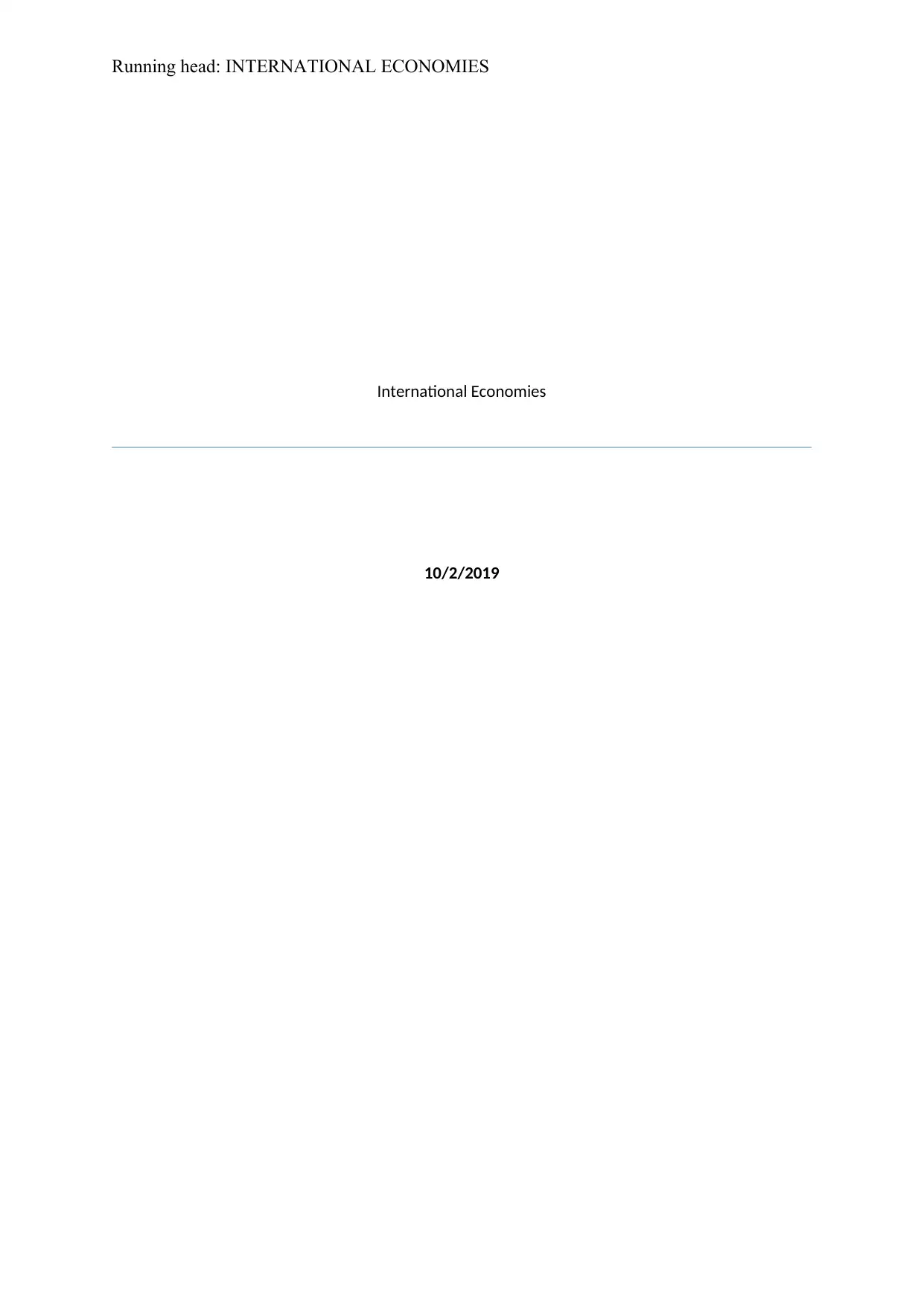
Running head: INTERNATIONAL ECONOMIES
International Economies
10/2/2019
International Economies
10/2/2019
Paraphrase This Document
Need a fresh take? Get an instant paraphrase of this document with our AI Paraphraser
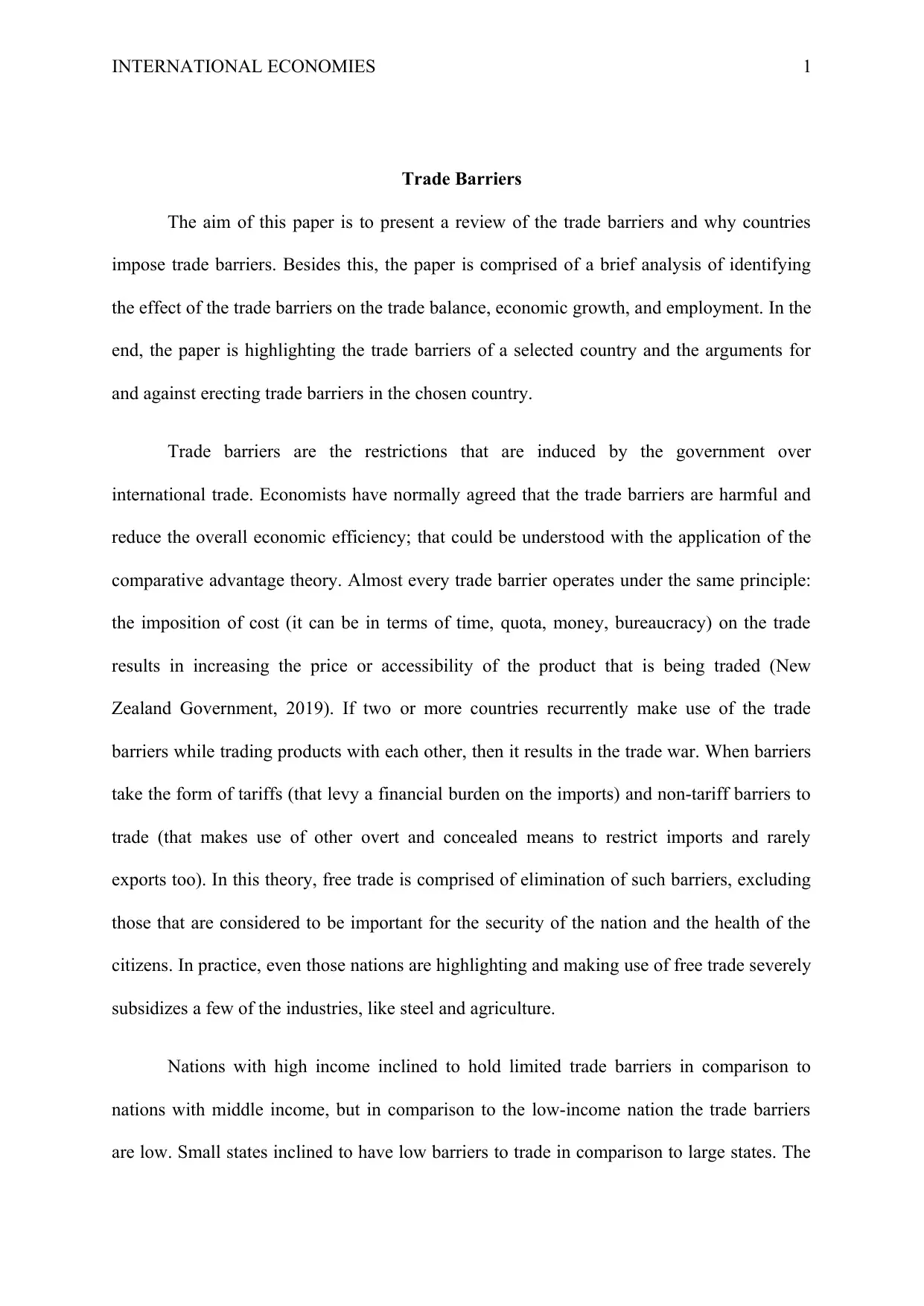
INTERNATIONAL ECONOMIES 1
Trade Barriers
The aim of this paper is to present a review of the trade barriers and why countries
impose trade barriers. Besides this, the paper is comprised of a brief analysis of identifying
the effect of the trade barriers on the trade balance, economic growth, and employment. In the
end, the paper is highlighting the trade barriers of a selected country and the arguments for
and against erecting trade barriers in the chosen country.
Trade barriers are the restrictions that are induced by the government over
international trade. Economists have normally agreed that the trade barriers are harmful and
reduce the overall economic efficiency; that could be understood with the application of the
comparative advantage theory. Almost every trade barrier operates under the same principle:
the imposition of cost (it can be in terms of time, quota, money, bureaucracy) on the trade
results in increasing the price or accessibility of the product that is being traded (New
Zealand Government, 2019). If two or more countries recurrently make use of the trade
barriers while trading products with each other, then it results in the trade war. When barriers
take the form of tariffs (that levy a financial burden on the imports) and non-tariff barriers to
trade (that makes use of other overt and concealed means to restrict imports and rarely
exports too). In this theory, free trade is comprised of elimination of such barriers, excluding
those that are considered to be important for the security of the nation and the health of the
citizens. In practice, even those nations are highlighting and making use of free trade severely
subsidizes a few of the industries, like steel and agriculture.
Nations with high income inclined to hold limited trade barriers in comparison to
nations with middle income, but in comparison to the low-income nation the trade barriers
are low. Small states inclined to have low barriers to trade in comparison to large states. The
Trade Barriers
The aim of this paper is to present a review of the trade barriers and why countries
impose trade barriers. Besides this, the paper is comprised of a brief analysis of identifying
the effect of the trade barriers on the trade balance, economic growth, and employment. In the
end, the paper is highlighting the trade barriers of a selected country and the arguments for
and against erecting trade barriers in the chosen country.
Trade barriers are the restrictions that are induced by the government over
international trade. Economists have normally agreed that the trade barriers are harmful and
reduce the overall economic efficiency; that could be understood with the application of the
comparative advantage theory. Almost every trade barrier operates under the same principle:
the imposition of cost (it can be in terms of time, quota, money, bureaucracy) on the trade
results in increasing the price or accessibility of the product that is being traded (New
Zealand Government, 2019). If two or more countries recurrently make use of the trade
barriers while trading products with each other, then it results in the trade war. When barriers
take the form of tariffs (that levy a financial burden on the imports) and non-tariff barriers to
trade (that makes use of other overt and concealed means to restrict imports and rarely
exports too). In this theory, free trade is comprised of elimination of such barriers, excluding
those that are considered to be important for the security of the nation and the health of the
citizens. In practice, even those nations are highlighting and making use of free trade severely
subsidizes a few of the industries, like steel and agriculture.
Nations with high income inclined to hold limited trade barriers in comparison to
nations with middle income, but in comparison to the low-income nation the trade barriers
are low. Small states inclined to have low barriers to trade in comparison to large states. The
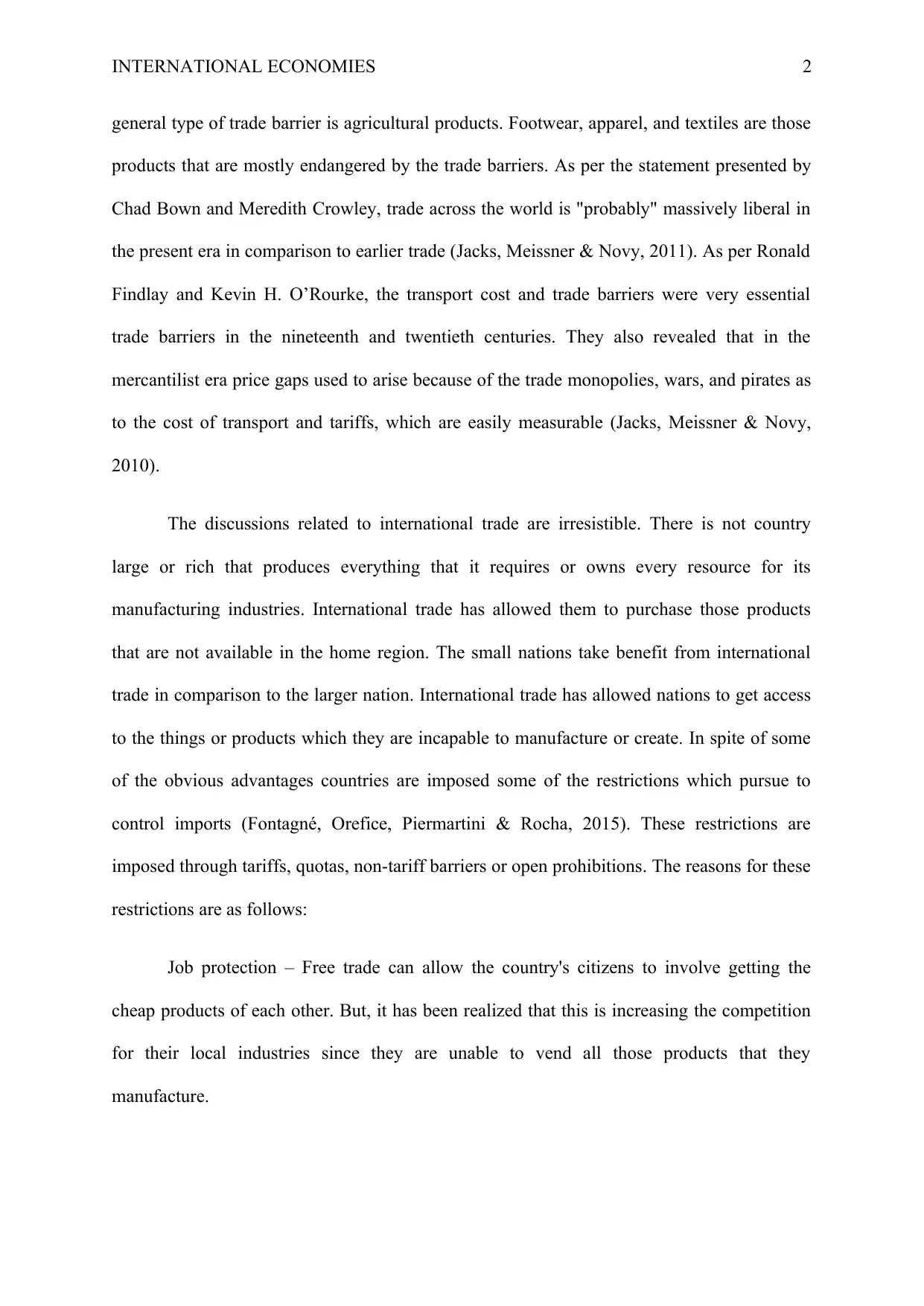
INTERNATIONAL ECONOMIES 2
general type of trade barrier is agricultural products. Footwear, apparel, and textiles are those
products that are mostly endangered by the trade barriers. As per the statement presented by
Chad Bown and Meredith Crowley, trade across the world is "probably" massively liberal in
the present era in comparison to earlier trade (Jacks, Meissner & Novy, 2011). As per Ronald
Findlay and Kevin H. O’Rourke, the transport cost and trade barriers were very essential
trade barriers in the nineteenth and twentieth centuries. They also revealed that in the
mercantilist era price gaps used to arise because of the trade monopolies, wars, and pirates as
to the cost of transport and tariffs, which are easily measurable (Jacks, Meissner & Novy,
2010).
The discussions related to international trade are irresistible. There is not country
large or rich that produces everything that it requires or owns every resource for its
manufacturing industries. International trade has allowed them to purchase those products
that are not available in the home region. The small nations take benefit from international
trade in comparison to the larger nation. International trade has allowed nations to get access
to the things or products which they are incapable to manufacture or create. In spite of some
of the obvious advantages countries are imposed some of the restrictions which pursue to
control imports (Fontagné, Orefice, Piermartini & Rocha, 2015). These restrictions are
imposed through tariffs, quotas, non-tariff barriers or open prohibitions. The reasons for these
restrictions are as follows:
Job protection – Free trade can allow the country's citizens to involve getting the
cheap products of each other. But, it has been realized that this is increasing the competition
for their local industries since they are unable to vend all those products that they
manufacture.
general type of trade barrier is agricultural products. Footwear, apparel, and textiles are those
products that are mostly endangered by the trade barriers. As per the statement presented by
Chad Bown and Meredith Crowley, trade across the world is "probably" massively liberal in
the present era in comparison to earlier trade (Jacks, Meissner & Novy, 2011). As per Ronald
Findlay and Kevin H. O’Rourke, the transport cost and trade barriers were very essential
trade barriers in the nineteenth and twentieth centuries. They also revealed that in the
mercantilist era price gaps used to arise because of the trade monopolies, wars, and pirates as
to the cost of transport and tariffs, which are easily measurable (Jacks, Meissner & Novy,
2010).
The discussions related to international trade are irresistible. There is not country
large or rich that produces everything that it requires or owns every resource for its
manufacturing industries. International trade has allowed them to purchase those products
that are not available in the home region. The small nations take benefit from international
trade in comparison to the larger nation. International trade has allowed nations to get access
to the things or products which they are incapable to manufacture or create. In spite of some
of the obvious advantages countries are imposed some of the restrictions which pursue to
control imports (Fontagné, Orefice, Piermartini & Rocha, 2015). These restrictions are
imposed through tariffs, quotas, non-tariff barriers or open prohibitions. The reasons for these
restrictions are as follows:
Job protection – Free trade can allow the country's citizens to involve getting the
cheap products of each other. But, it has been realized that this is increasing the competition
for their local industries since they are unable to vend all those products that they
manufacture.
⊘ This is a preview!⊘
Do you want full access?
Subscribe today to unlock all pages.

Trusted by 1+ million students worldwide
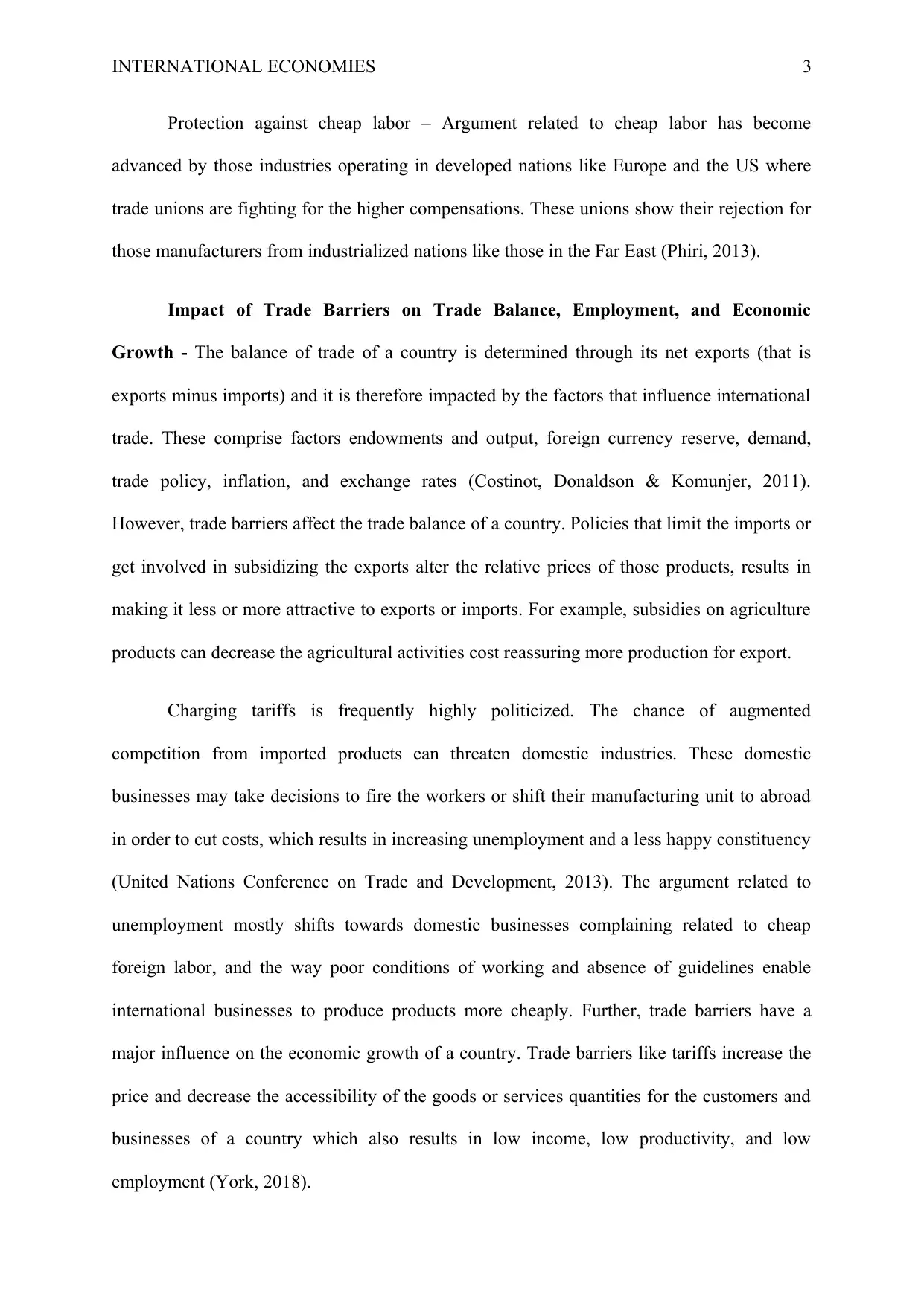
INTERNATIONAL ECONOMIES 3
Protection against cheap labor – Argument related to cheap labor has become
advanced by those industries operating in developed nations like Europe and the US where
trade unions are fighting for the higher compensations. These unions show their rejection for
those manufacturers from industrialized nations like those in the Far East (Phiri, 2013).
Impact of Trade Barriers on Trade Balance, Employment, and Economic
Growth - The balance of trade of a country is determined through its net exports (that is
exports minus imports) and it is therefore impacted by the factors that influence international
trade. These comprise factors endowments and output, foreign currency reserve, demand,
trade policy, inflation, and exchange rates (Costinot, Donaldson & Komunjer, 2011).
However, trade barriers affect the trade balance of a country. Policies that limit the imports or
get involved in subsidizing the exports alter the relative prices of those products, results in
making it less or more attractive to exports or imports. For example, subsidies on agriculture
products can decrease the agricultural activities cost reassuring more production for export.
Charging tariffs is frequently highly politicized. The chance of augmented
competition from imported products can threaten domestic industries. These domestic
businesses may take decisions to fire the workers or shift their manufacturing unit to abroad
in order to cut costs, which results in increasing unemployment and a less happy constituency
(United Nations Conference on Trade and Development, 2013). The argument related to
unemployment mostly shifts towards domestic businesses complaining related to cheap
foreign labor, and the way poor conditions of working and absence of guidelines enable
international businesses to produce products more cheaply. Further, trade barriers have a
major influence on the economic growth of a country. Trade barriers like tariffs increase the
price and decrease the accessibility of the goods or services quantities for the customers and
businesses of a country which also results in low income, low productivity, and low
employment (York, 2018).
Protection against cheap labor – Argument related to cheap labor has become
advanced by those industries operating in developed nations like Europe and the US where
trade unions are fighting for the higher compensations. These unions show their rejection for
those manufacturers from industrialized nations like those in the Far East (Phiri, 2013).
Impact of Trade Barriers on Trade Balance, Employment, and Economic
Growth - The balance of trade of a country is determined through its net exports (that is
exports minus imports) and it is therefore impacted by the factors that influence international
trade. These comprise factors endowments and output, foreign currency reserve, demand,
trade policy, inflation, and exchange rates (Costinot, Donaldson & Komunjer, 2011).
However, trade barriers affect the trade balance of a country. Policies that limit the imports or
get involved in subsidizing the exports alter the relative prices of those products, results in
making it less or more attractive to exports or imports. For example, subsidies on agriculture
products can decrease the agricultural activities cost reassuring more production for export.
Charging tariffs is frequently highly politicized. The chance of augmented
competition from imported products can threaten domestic industries. These domestic
businesses may take decisions to fire the workers or shift their manufacturing unit to abroad
in order to cut costs, which results in increasing unemployment and a less happy constituency
(United Nations Conference on Trade and Development, 2013). The argument related to
unemployment mostly shifts towards domestic businesses complaining related to cheap
foreign labor, and the way poor conditions of working and absence of guidelines enable
international businesses to produce products more cheaply. Further, trade barriers have a
major influence on the economic growth of a country. Trade barriers like tariffs increase the
price and decrease the accessibility of the goods or services quantities for the customers and
businesses of a country which also results in low income, low productivity, and low
employment (York, 2018).
Paraphrase This Document
Need a fresh take? Get an instant paraphrase of this document with our AI Paraphraser
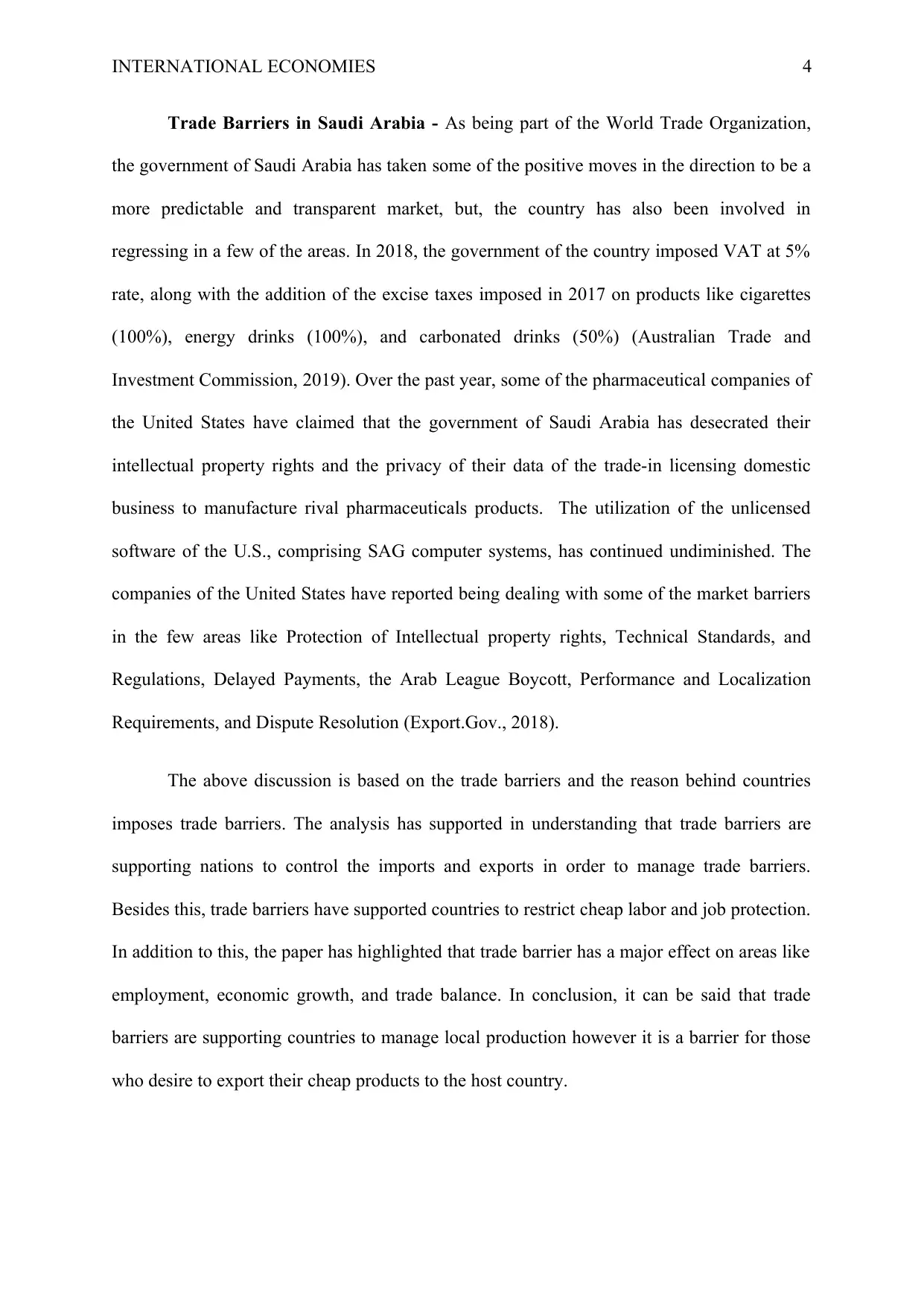
INTERNATIONAL ECONOMIES 4
Trade Barriers in Saudi Arabia - As being part of the World Trade Organization,
the government of Saudi Arabia has taken some of the positive moves in the direction to be a
more predictable and transparent market, but, the country has also been involved in
regressing in a few of the areas. In 2018, the government of the country imposed VAT at 5%
rate, along with the addition of the excise taxes imposed in 2017 on products like cigarettes
(100%), energy drinks (100%), and carbonated drinks (50%) (Australian Trade and
Investment Commission, 2019). Over the past year, some of the pharmaceutical companies of
the United States have claimed that the government of Saudi Arabia has desecrated their
intellectual property rights and the privacy of their data of the trade-in licensing domestic
business to manufacture rival pharmaceuticals products. The utilization of the unlicensed
software of the U.S., comprising SAG computer systems, has continued undiminished. The
companies of the United States have reported being dealing with some of the market barriers
in the few areas like Protection of Intellectual property rights, Technical Standards, and
Regulations, Delayed Payments, the Arab League Boycott, Performance and Localization
Requirements, and Dispute Resolution (Export.Gov., 2018).
The above discussion is based on the trade barriers and the reason behind countries
imposes trade barriers. The analysis has supported in understanding that trade barriers are
supporting nations to control the imports and exports in order to manage trade barriers.
Besides this, trade barriers have supported countries to restrict cheap labor and job protection.
In addition to this, the paper has highlighted that trade barrier has a major effect on areas like
employment, economic growth, and trade balance. In conclusion, it can be said that trade
barriers are supporting countries to manage local production however it is a barrier for those
who desire to export their cheap products to the host country.
Trade Barriers in Saudi Arabia - As being part of the World Trade Organization,
the government of Saudi Arabia has taken some of the positive moves in the direction to be a
more predictable and transparent market, but, the country has also been involved in
regressing in a few of the areas. In 2018, the government of the country imposed VAT at 5%
rate, along with the addition of the excise taxes imposed in 2017 on products like cigarettes
(100%), energy drinks (100%), and carbonated drinks (50%) (Australian Trade and
Investment Commission, 2019). Over the past year, some of the pharmaceutical companies of
the United States have claimed that the government of Saudi Arabia has desecrated their
intellectual property rights and the privacy of their data of the trade-in licensing domestic
business to manufacture rival pharmaceuticals products. The utilization of the unlicensed
software of the U.S., comprising SAG computer systems, has continued undiminished. The
companies of the United States have reported being dealing with some of the market barriers
in the few areas like Protection of Intellectual property rights, Technical Standards, and
Regulations, Delayed Payments, the Arab League Boycott, Performance and Localization
Requirements, and Dispute Resolution (Export.Gov., 2018).
The above discussion is based on the trade barriers and the reason behind countries
imposes trade barriers. The analysis has supported in understanding that trade barriers are
supporting nations to control the imports and exports in order to manage trade barriers.
Besides this, trade barriers have supported countries to restrict cheap labor and job protection.
In addition to this, the paper has highlighted that trade barrier has a major effect on areas like
employment, economic growth, and trade balance. In conclusion, it can be said that trade
barriers are supporting countries to manage local production however it is a barrier for those
who desire to export their cheap products to the host country.
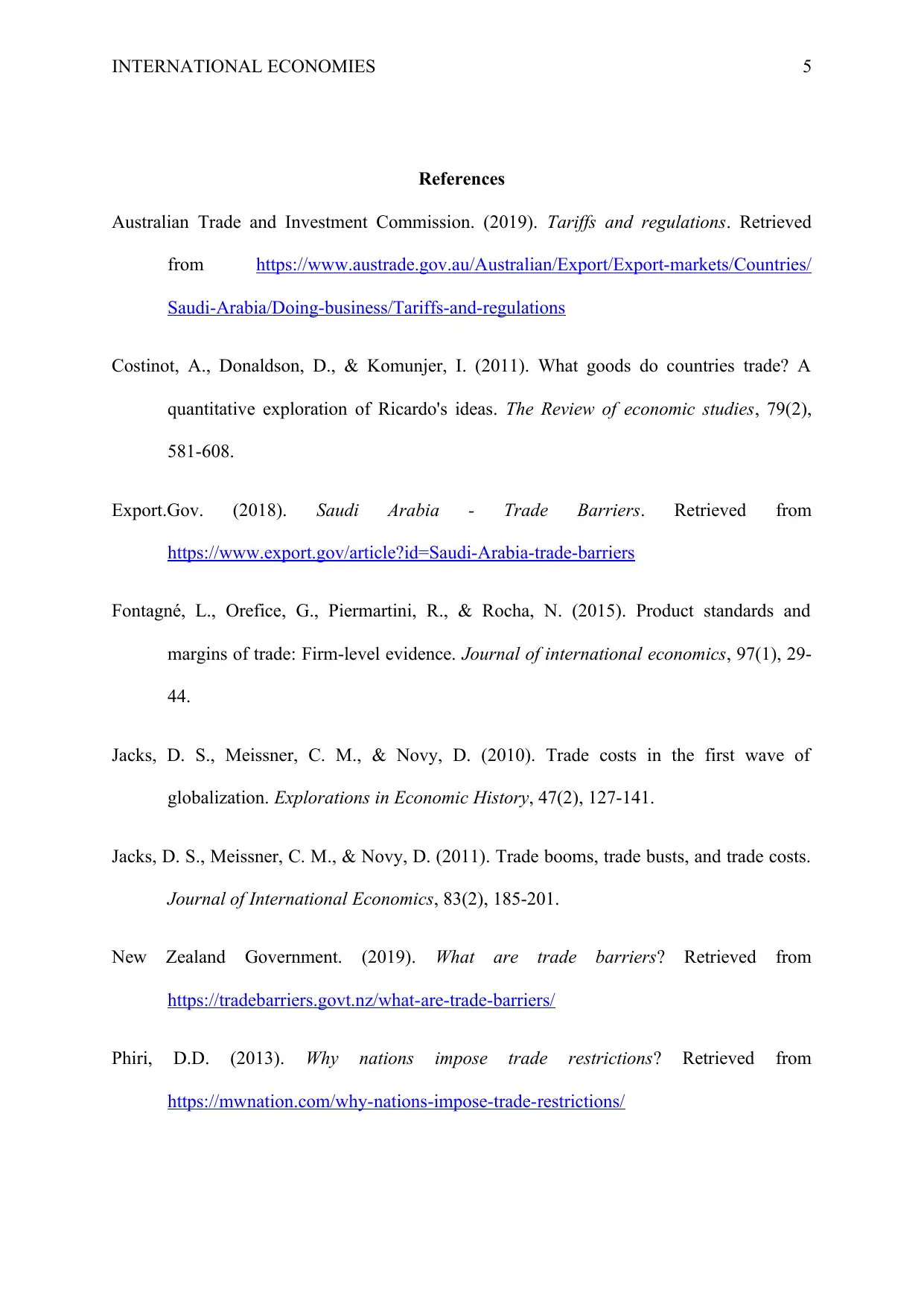
INTERNATIONAL ECONOMIES 5
References
Australian Trade and Investment Commission. (2019). Tariffs and regulations. Retrieved
from https://www.austrade.gov.au/Australian/Export/Export-markets/Countries/
Saudi-Arabia/Doing-business/Tariffs-and-regulations
Costinot, A., Donaldson, D., & Komunjer, I. (2011). What goods do countries trade? A
quantitative exploration of Ricardo's ideas. The Review of economic studies, 79(2),
581-608.
Export.Gov. (2018). Saudi Arabia - Trade Barriers. Retrieved from
https://www.export.gov/article?id=Saudi-Arabia-trade-barriers
Fontagné, L., Orefice, G., Piermartini, R., & Rocha, N. (2015). Product standards and
margins of trade: Firm-level evidence. Journal of international economics, 97(1), 29-
44.
Jacks, D. S., Meissner, C. M., & Novy, D. (2010). Trade costs in the first wave of
globalization. Explorations in Economic History, 47(2), 127-141.
Jacks, D. S., Meissner, C. M., & Novy, D. (2011). Trade booms, trade busts, and trade costs.
Journal of International Economics, 83(2), 185-201.
New Zealand Government. (2019). What are trade barriers? Retrieved from
https://tradebarriers.govt.nz/what-are-trade-barriers/
Phiri, D.D. (2013). Why nations impose trade restrictions? Retrieved from
https://mwnation.com/why-nations-impose-trade-restrictions/
References
Australian Trade and Investment Commission. (2019). Tariffs and regulations. Retrieved
from https://www.austrade.gov.au/Australian/Export/Export-markets/Countries/
Saudi-Arabia/Doing-business/Tariffs-and-regulations
Costinot, A., Donaldson, D., & Komunjer, I. (2011). What goods do countries trade? A
quantitative exploration of Ricardo's ideas. The Review of economic studies, 79(2),
581-608.
Export.Gov. (2018). Saudi Arabia - Trade Barriers. Retrieved from
https://www.export.gov/article?id=Saudi-Arabia-trade-barriers
Fontagné, L., Orefice, G., Piermartini, R., & Rocha, N. (2015). Product standards and
margins of trade: Firm-level evidence. Journal of international economics, 97(1), 29-
44.
Jacks, D. S., Meissner, C. M., & Novy, D. (2010). Trade costs in the first wave of
globalization. Explorations in Economic History, 47(2), 127-141.
Jacks, D. S., Meissner, C. M., & Novy, D. (2011). Trade booms, trade busts, and trade costs.
Journal of International Economics, 83(2), 185-201.
New Zealand Government. (2019). What are trade barriers? Retrieved from
https://tradebarriers.govt.nz/what-are-trade-barriers/
Phiri, D.D. (2013). Why nations impose trade restrictions? Retrieved from
https://mwnation.com/why-nations-impose-trade-restrictions/
⊘ This is a preview!⊘
Do you want full access?
Subscribe today to unlock all pages.

Trusted by 1+ million students worldwide
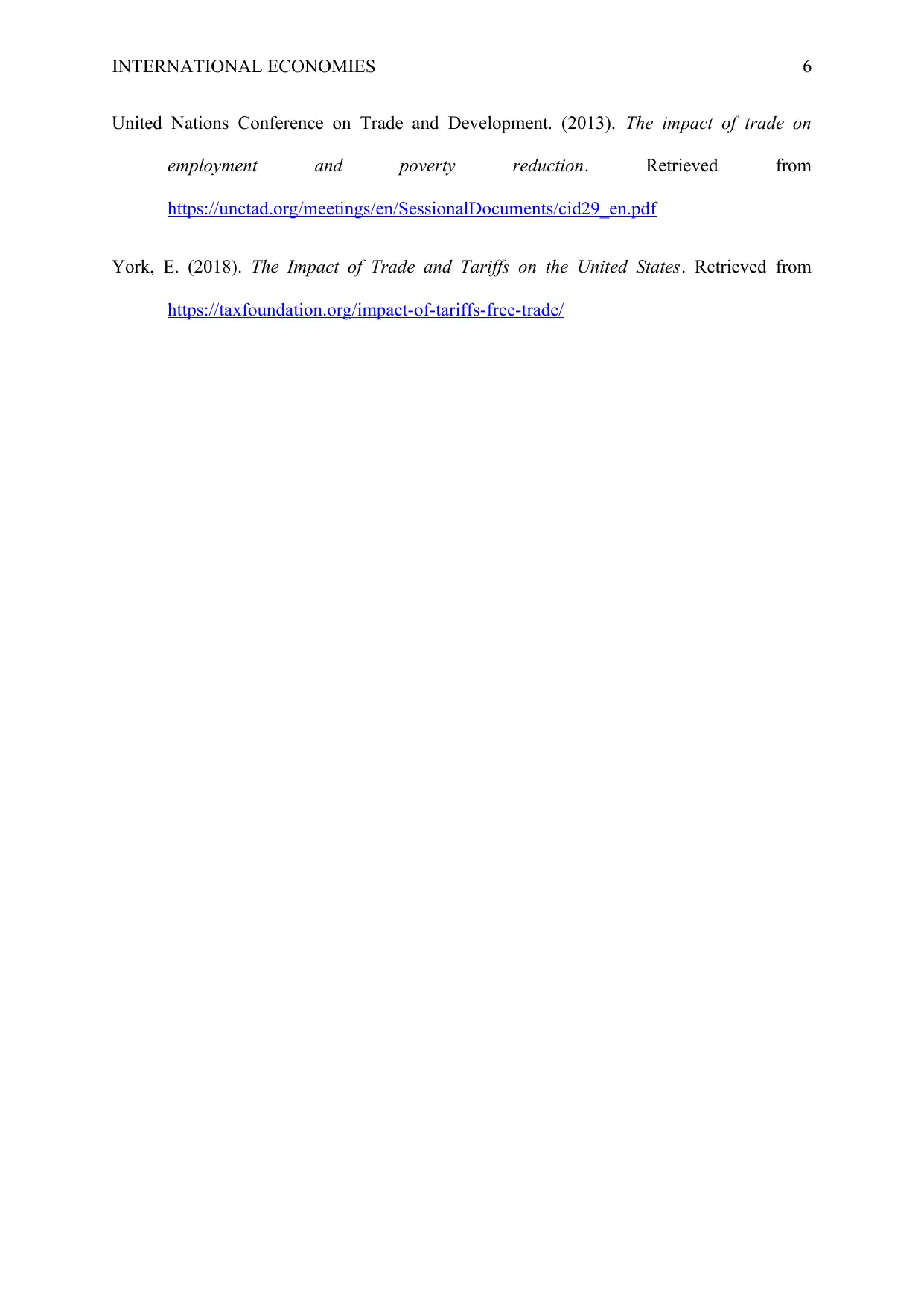
INTERNATIONAL ECONOMIES 6
United Nations Conference on Trade and Development. (2013). The impact of trade on
employment and poverty reduction. Retrieved from
https://unctad.org/meetings/en/SessionalDocuments/cid29_en.pdf
York, E. (2018). The Impact of Trade and Tariffs on the United States. Retrieved from
https://taxfoundation.org/impact-of-tariffs-free-trade/
United Nations Conference on Trade and Development. (2013). The impact of trade on
employment and poverty reduction. Retrieved from
https://unctad.org/meetings/en/SessionalDocuments/cid29_en.pdf
York, E. (2018). The Impact of Trade and Tariffs on the United States. Retrieved from
https://taxfoundation.org/impact-of-tariffs-free-trade/
1 out of 7
Related Documents
Your All-in-One AI-Powered Toolkit for Academic Success.
+13062052269
info@desklib.com
Available 24*7 on WhatsApp / Email
![[object Object]](/_next/static/media/star-bottom.7253800d.svg)
Unlock your academic potential
Copyright © 2020–2025 A2Z Services. All Rights Reserved. Developed and managed by ZUCOL.





